MEASUREMENT
WHILE
DRILLING
BACKGROUND
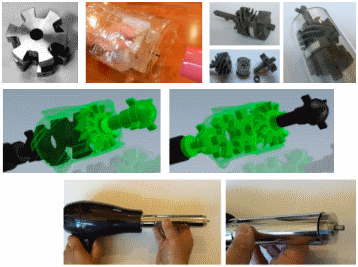
MWD poppet valves consume excessive energy while negative pulsers damage formations - both offer low data rates. Sirens are superior: they are energy efficient because they do not completely stop the flow and high data rates are possible because continuous frequency modulation is more easily detected than discrete amplitude signals. Still, testing and evaluation in metal can be expensive even for a single prototype. Mr. Chin pioneered the use of wind tunnels for MWD siren, turbine and telemetry testing; such facilities have since been used to reduce erosion for strainers, hydraulic fracturing tools, drillbits and so on.
Sirens are known to jam, turning to a closed position that blocks oncoming mud and introducing operational problems. The very first use of wind tunnels led to Schlumberger's "stable open" (tapered rotor downstream) siren in U.S. Patent 4,785,300, quickly followed by numerous industry innovations in optimizing downhole tools and increasing signal processing throughput. Read about our innovations in MWD Signal Analysis, Optimization and Design (co-authored with CNPC) where test methods, historical perspectives and mathematical algorithms are described in detail. The above photo shows generic sirens, "turbosirens" that spin without motor assistance, very low torque, miniature self-spinning sirens driven at minimal hair dryer flow rates (movies available on request). An interesting survey of test methods appears below.
SCHLUMBERGER
ANADRILL
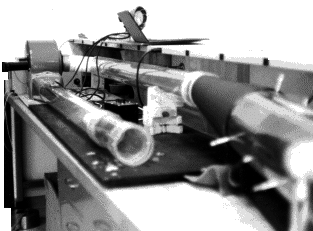
This early test fixture, introduced by Mr. Chin, is the first wind tunnel ever used for MWD testing. More advanced facilities were later developed in the United Kingdom and published in the open literature. This "short wind tunnel," used for siren torque, erosion and signal strength evaluation, was driven by a simple squirrel cage blower and electric controller. The facility was also used to design a family of downhole turbines.
HALLIBURTON
ENERGY
SERVICES
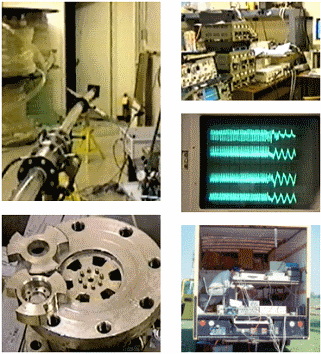
Halliburton's test facility consisted of short and long (2,000 ft) components, the former for torque, signal and erosion evaluation, the latter for telemetry design. Patents for multiple transducer echo cancellation, signal enhancement by constructive wave interference, "100 feet hose" analog amplifiers, and other innovations, were developed in the lab. The test section, hydraulically controlled to allow both rotation and reciprocation, was fabricated in metal. Importantly, the entire system could be removed, placed in a truck and transported to the field for testing in real muds and wells.
CHINA
NATIONAL
PETROLEUM
CORPORATION
(CNPC)
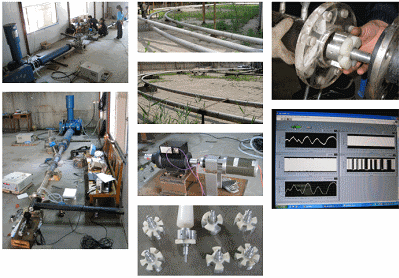
CNPC's wind tunnel consists of short and long portions, the former driven by a powerful blower suitable for positive pulser and siren testing, while the latter, wrapping around the test shed multiple times, is designed for telemetry evaluation. Dozens of siren prototypes have been evaluated with respect to torque, signal strength, as well as harmonic efficiency at different rotation and flow rates. Detailed torque and signal strength data are available for "mix and match, multiple sirens-in-series" applications.

CNPC mud siren prototype.
SINOPEC

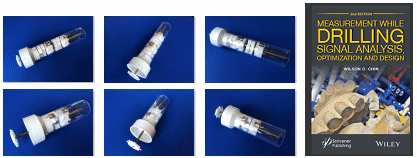
The Sinopec wind tunnel, located in Southern China, is a convenient table-top fixture also designed to evaluate torque, signal strength and erosion in its short section, and telemetry concepts and signal processing in its detachable long section. The company is committed to basic research and focuses on "unusual" siren geometries. Read all about high data rate "turbosirens" in Mr. Chin's updated MWD book.
GYRODATA
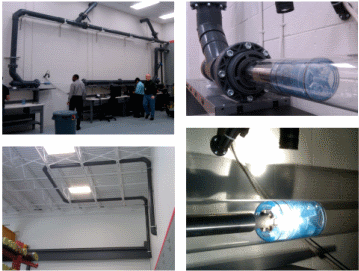
The impressive facility at Gyrodata's Houston headquarters was initially designed to solve severe erosion problems with its rotaty pulsers. Neutrally buoyant helium filled soap bubbles pumped from a centrifugal separator flow past the rotating valve. Rapid impingements are photographed with a high-speed camera, saved in massive storage devices, and broadcast to engineers worldwide for real-time collaboration. Geometric modifications using modeling clay are quickly evaluated, results are incorporated into fluid modeling software, and prototypes are quickly drawn and 3D printed for further wind tunnel evaluation.
The company's long wind tunnel is also state-of-the-art. A shut-off valve redirects flow from the shorter loop to a massive piping system mounted at the ceiling of an adjacent large crane bay and storage area. Large flow rates are accommodated using a powerful two-story blower located external to the test shed.
GE
OIL &
GAS

General Electric Research Center, GE Oil & Gas Technology Center, Oklahoma City, OK
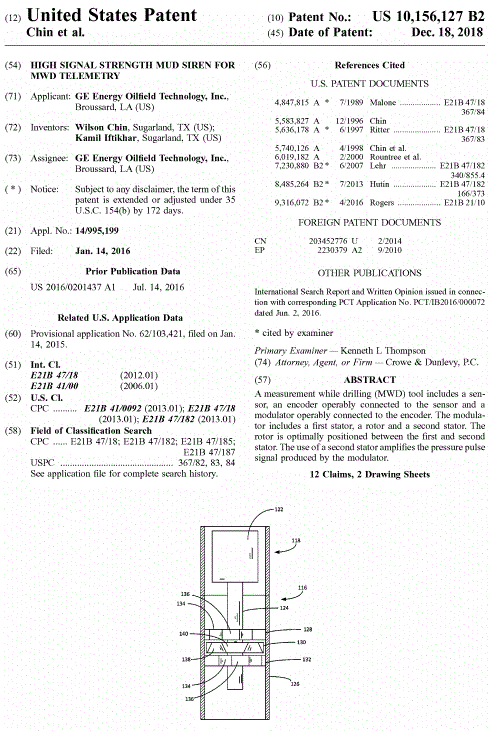
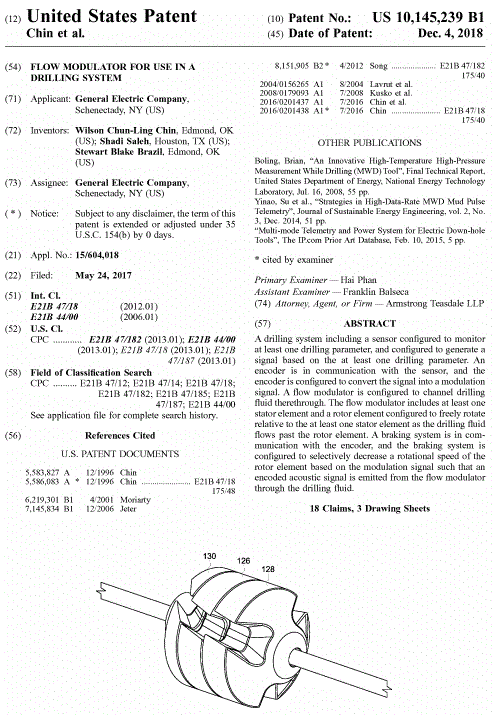
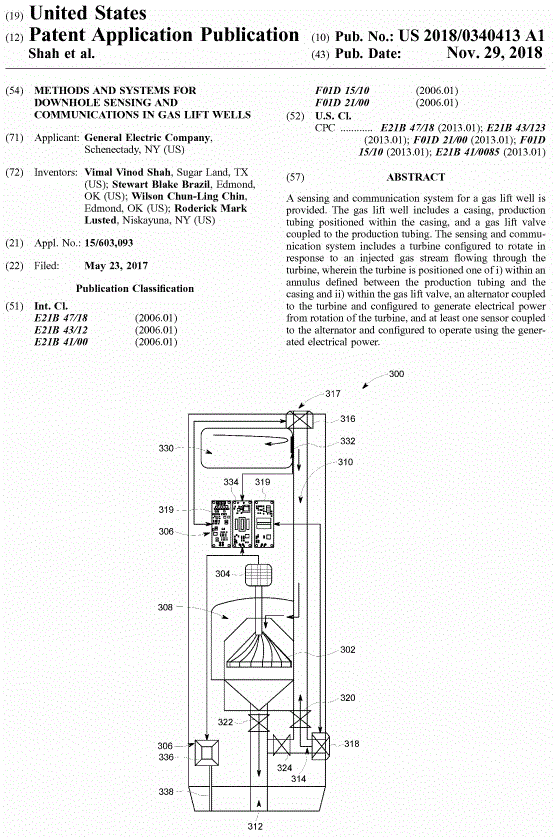
Recently issued, United States Patent 10,273,801, April 2019.
General Electric's wind tunnels at its Oklahoma Oil & Gas Technology Center and Shanghai, China locations are second to none. While we cannot divulge details, our latest patents above shed insight on "cool" MWD signal sources to come. The above inventions disclose a new siren that, for like rotation and flow rates, produces twice the signal found in existing sirens and simu, implying high data-rate and deep hole capabilities.
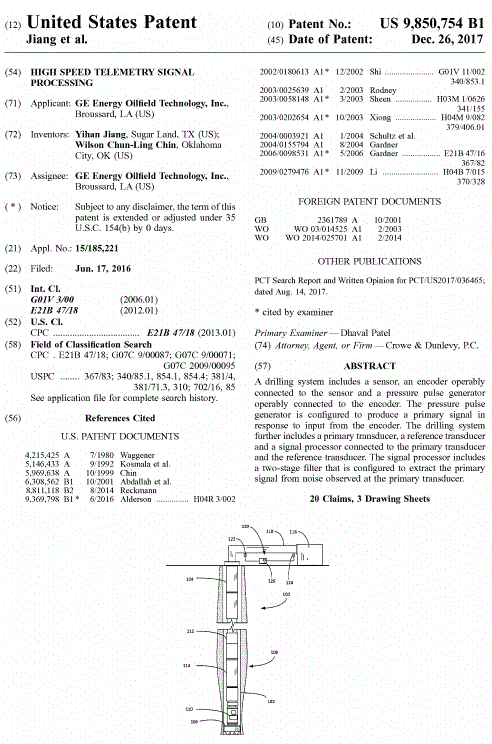
-
Gone are the days when MWD telemetry systems were designed at the drafting table. Today's sirens are technology driven, and telemetry schemes (as suggested above) are tested under controlled conditions, where everything that could go wrong is simulated and corrected.
In 2014 and 2018, we published two ground-breaking books on high-data-rate mud pulse telemetry, reporting on new developments, e.g., self-spinning sirens creating signal amplitudes in excess of 300 Hz carrier frequencies. The signals that result can be detected at the surface because "sirens in series stacking" supports creation of as much signal as needed with minimal energy cost. A complete foundational technology is presented in our 2025 AADE paper and we are presently identifying potential collaborators. Let's here from you today!
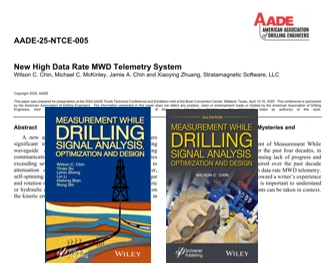
Home | Team Members | Papers | Patents | Books | Brochures | Contact |
Research, Science and Engineering
Home | Measurement While Drilling | Formation Testing | Fluid Rheology | Managed Pressure Drilling | Reservoir Engineering | Electromagnetic Modeling | Waves and Vibrations | Aerodynamics | Biomedical Imaging |Copyright (C) 2025, by Stratamagnetic Software, LLC. All rights reserved.